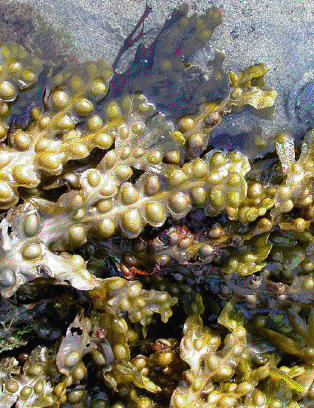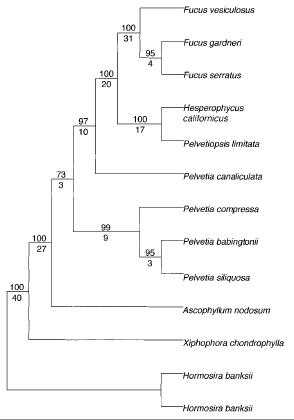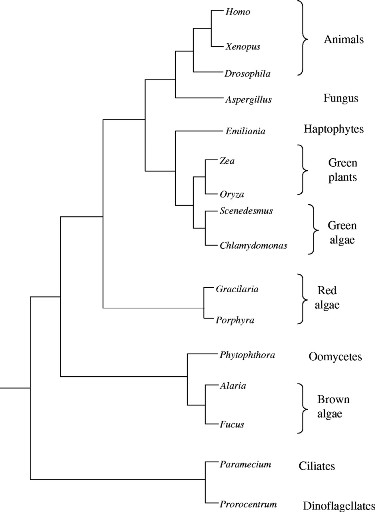
What we learned in Class(ification)
 Domain- Eukaryotic
Domain- Eukaryotic
Kingdom- Chromista
Phylum- Heterokontophyta
Class- Phaeophyceae
Order- Fucales
Family- Fucaceae
Genus- Fucus
Species- Fucus vesiculosus
Domain - Eukaryotic
All organisms within this domain have a
true nucleus and membrane bound organelles.
Kingdom - Chromista
Chromista translates into the word
"colored." Organisms within this kingdom are mostly
photosynthetic. They also contain chlorophyll c, which is what
sets this kingdom apart from the kingdom plantae, who do not
contain this chlorophyll (plants).
Phylum - Heterokontophyta
Organisms within this phylum have sperm that possess flagella of
unequal lengths, one is on the anterior portion of the
sperm, which is useless for motility, and one is a posterior
flagellum that the sperm uses for movement. Sperm also have an
eyespot located near the anterior end of the cell. The eyespot
is used as a photoreceptor organ, and is used to direct the
cell.
Class - Phaeophyceae
This is the class that all brown
algae reside in. The brown algae derive their color from large
amounts of a pigment called fucoxanthin in their
chloroplasts.
Order - Fucales
The organisms in this order are
parenchymatous
with growth from an apical cell, which is at the tip of the blade. The haploid generation (the part of
the lifecycle that only has one set of chromosomes) is reduced to an
egg and sperm, and the rest of the life cycle is diploid. The sperm
and egg are born in a conceptacles, special cavities where only the
gametes are borne.
Family - Fucaceae
Algae within this family are the only ones with
a four-sided apical cell at maturity. The branching is basically
dichotomous and in one plane, although some genera have
monopodial
branching.
Genus -
Fucus
Species within this genus have blades that are very branched
and supported by a narrow stalk that is attached to a discoid
holdfast. The blade has a flattened segment having a central midrib
(a prominent vein-like structure) surrounded on both sides by a narrower wing.
Species -
Fucus vesiculosus
The specific classification of F. vesiculosus.
Vesiculosus translated from Latin means literally "covered with tiny
bladders or blisters." The species is usually found with bladders in
pairs on its thallus, and smooth edges around the outside of the
blade (the picture above the genus description isn't very typical
since the edges look slightly serrated).
"The Tree(s) of Life"
The following images phylogenetic trees that show where F.
vesiculosus fits in among other organisms. The tree on the left
(Phylogenetic Tree A) shows a larger classification of organisms,
from animals, which humans are in (Genus Homo) down to the
brown algae where F. vesiculosus fits in. The tree on the
right (Phylogenetic Tree B) shows where F. vesiculosus fits
in among other brown algae.
|
 |
|
|
Phylogenetic Tree A |
Phylogenetic Tree B |
Phylogenetic tree A shows the Fucus genus relative to a broader set of genera than the one found to the right. This classification of genera is based off of a small-subunit (SSU) of Ribosomal Ribonucleic acid (rRNA). This testing is used a lot to classify different organisms and their origins relative to others. The tree was made by Donald F. Kapraun out of the University of North Carolina-Wilmington in 2004.
Phylogenetic tree B shows where F. vesiculosus fits in among other types of brown algae. The basis for this tree was an internal transcribed spacer within the species' nuclear ribosomal DNA. Ester Serrão, Lawrence Alice and Susan Brawley out of the University of Maine used samples of these species to come up with this phylogenetic tree in 1999. This is an older version of the phylogenetic tree, but there is new data under review that further resolves the position of F. vesiculosus relative to its neighbors.



